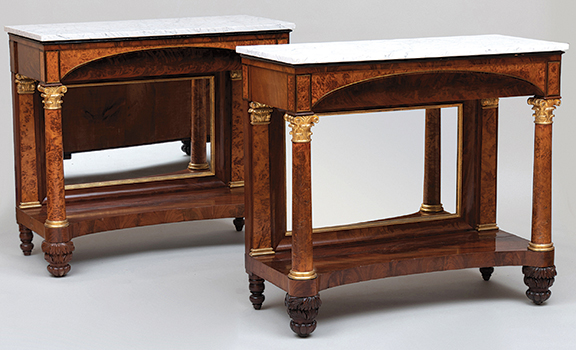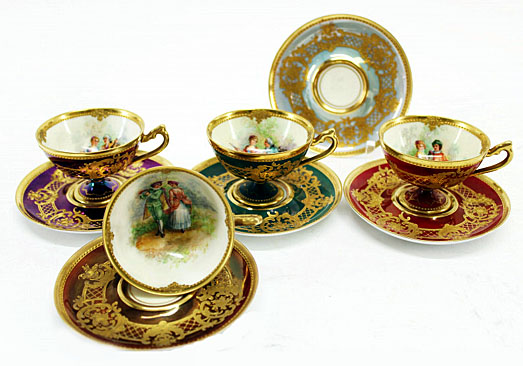 QUESTION: I recently purchased a mug that seems to be made of cut glass with red band and gold decoration at a local antique coop. Is this ruby glass?
QUESTION: I recently purchased a mug that seems to be made of cut glass with red band and gold decoration at a local antique coop. Is this ruby glass?
ANSWER: What you have is a mug of ruby stained glass, in which artisans painted a piece of pressed glass with a solution that turned red after firing a second time. True ruby glass is red all the way through. Glass makers originally created the deep ruby red color by adding gold, but that was rather expensive, making this type of glass costly.
 Bohemian glass makers discovered ruby glass in the second half of the 17th century when Bohemian glass makers, in their effort to imitate Venetian glass, had only a colorless potash-lime glass with which to work. And although it could be decorated, colored glass wasn’t possible.
Bohemian glass makers discovered ruby glass in the second half of the 17th century when Bohemian glass makers, in their effort to imitate Venetian glass, had only a colorless potash-lime glass with which to work. And although it could be decorated, colored glass wasn’t possible.
Then someone discovered that glass could be colored red by adding an oxide of gold to the formula. As it came out of the pot it was amber, but when articles made in it were reheated they became a clear and true red.
 For a time this art seemed to have been lost, but Bohemian glass makers began making ruby glass again at the beginning of the 19th Century, but instead of being solid colored, they made pieces of colorless glass, then encased them with a thin layer of red.
For a time this art seemed to have been lost, but Bohemian glass makers began making ruby glass again at the beginning of the 19th Century, but instead of being solid colored, they made pieces of colorless glass, then encased them with a thin layer of red.
Ruby flash was a less expensive way to produce the glass within the blowing process. Glassblowers would blow glass a bit, then cool it, after which they dipped it into molten red glass, producing a layer of red over the clear glass. The coating on the clear glass consisted of a chemical solution containing copper sulfide that glass makers baked in a kiln, turning the coating bright red. With ruby flash glass, the entire piece of clear class became covered in red glass.
 This allowed a glass company to make pressed glass “blanks” and sell them to finishing companies, whose artisans would engrave patterns in the red coating, revealing the clear glass underneath. It’s this flashed glass, made around 1850, that’s commonly known today. Because of its two layers of glass, as it were, ruby flash glass offered an opportunity for dramatic cutting and engraving, the pattern showing up in the clear glass against the ruby ground. American glass makers went to work to imitate it and called it “Bohemian.”
This allowed a glass company to make pressed glass “blanks” and sell them to finishing companies, whose artisans would engrave patterns in the red coating, revealing the clear glass underneath. It’s this flashed glass, made around 1850, that’s commonly known today. Because of its two layers of glass, as it were, ruby flash glass offered an opportunity for dramatic cutting and engraving, the pattern showing up in the clear glass against the ruby ground. American glass makers went to work to imitate it and called it “Bohemian.”
Sometimes, glass companies “flashed” entire sets of dinnerware, occasionally adding touches of gold. Ruby flash’s popularity began to decline around 1929, probably due to the onset of the Great Depression.
 Of the various patterns of ruby flash glass, "King's Crown" was the most common. Several different glass companies made a variation of King's Crown. The name comes from the zig-zag design, like the top of a crown. Other popular patterns included “Ruby Thumbprint,” “Prize,” “Crystal Wedding” “Heart Band.”
Of the various patterns of ruby flash glass, "King's Crown" was the most common. Several different glass companies made a variation of King's Crown. The name comes from the zig-zag design, like the top of a crown. Other popular patterns included “Ruby Thumbprint,” “Prize,” “Crystal Wedding” “Heart Band.”
While glass makers used ruby glass for decorative wares—vases, urns, bottles, bowls, candy dishes, etc. It was also used for tableware such as goblets, wines, carafes, cordial sets, finger-bowls, fruit bowls, compotes and the like. Glass makers also produced dresser pieces, such as perfume bottles and pomade jars, as well as lamps and candlesticks in the rich red glass.
 Smaller items, sold as souvenirs, such as toothpick holders, tumblers, goblets, creamers and pitchers, were made in ruby-stained glass. Staining a piece of glass involved painting an already-pressed piece of clear pattern glass with a ruby-colored stain and reheating it to 1,000 degrees in a kiln which turned the coating bright red.
Smaller items, sold as souvenirs, such as toothpick holders, tumblers, goblets, creamers and pitchers, were made in ruby-stained glass. Staining a piece of glass involved painting an already-pressed piece of clear pattern glass with a ruby-colored stain and reheating it to 1,000 degrees in a kiln which turned the coating bright red.
 This enabled sellers to engrave a piece through its thin red coating with the name of a destination and the date, thus making the clear glass shine through. Glass makers created thousands of these small articles for the large expositions, such as the Chicago World’s Fair in 1893, as well as popular county fairs.
This enabled sellers to engrave a piece through its thin red coating with the name of a destination and the date, thus making the clear glass shine through. Glass makers created thousands of these small articles for the large expositions, such as the Chicago World’s Fair in 1893, as well as popular county fairs.
One of the more popular ruby stained patterns, Button Arches, introduced originally around 1898, continued in production until the 1960s and 1970s. The design consisted of slightly overlapping pointed arches around the bottom edges and covers of pieces, each arch containing tightly packed "buttons."
To read more articles on antiques, please visit the Antiques Articles section of my Web site. And to stay up to the minute on antiques and collectibles, please join the over 30,000 readers by following my free online magazine, #TheAntiquesAlmanac. Learn more about "Return to Toyland" in the 2024 Holiday Edition, online now. And to read daily posts about unique objects from the past and their histories, like the #Antiques and More Collection on Facebook.












































